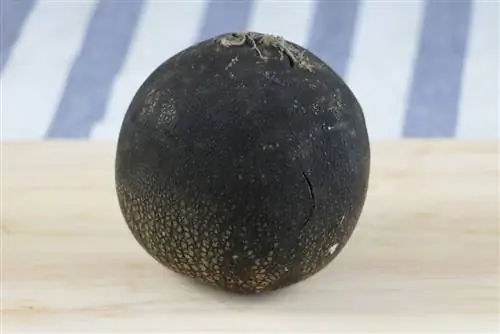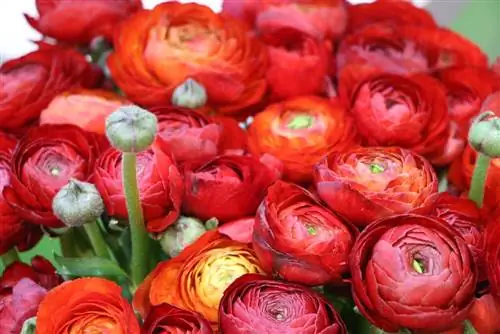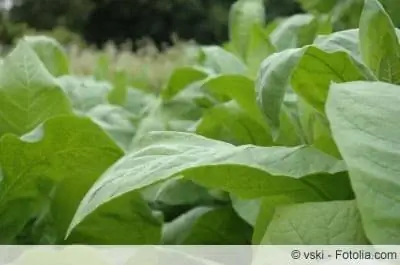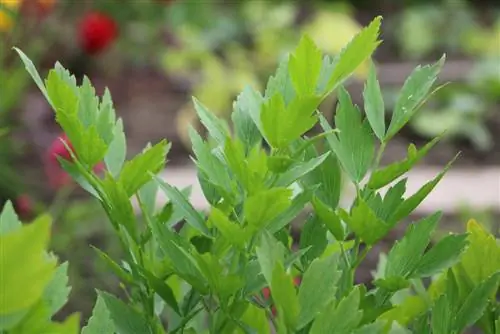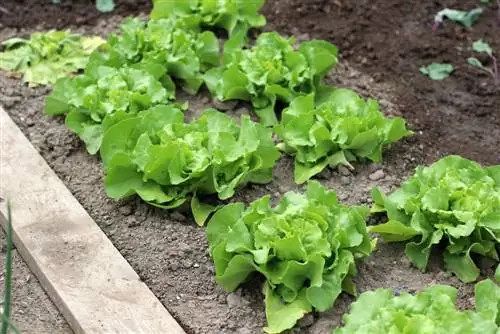- Author admin [email protected].
- Public 2023-12-17 03:39.
- Last modified 2025-01-24 12:45.
Radish is still one of the most popular vegetables. The radish owes this to its taste, which it gets from the mustard oils. In addition, the tuber vegetables have many different vitamins and minerals. The different radish varieties can be classified into two main groups. There are large radishes and small radishes. The large radishes are divided into red, black and white radishes. The small to medium-sized radish varieties are radishes.
Selecting the variety for cultivation
There are a variety of different radish varieties, many of which can be grown in the home garden. This includes the garden radish, which is around 20 centimeters long, has the familiar white color and tastes mildly spicy. The Hildis is a blue radish that, unlike the white radish, is not harvested in summer, but in autumn or winter. This radish has a stronger flavor and can be stored for a long time. The Icicle variety is a very long radish variety. It is a white variety that grows in a cylinder shape and has a very spicy taste. Last but not least, there is the Champion variety. These are scarlet radishes. These small, spherical radishes also have a spicy taste of their own.
Selecting the site and preparing the soil
All radish varieties require a location that is slightly moist and sunny. The soil should neither be too loose nor dry. However, before sowing, care should be taken to ensure that it has been thoroughly loosened and is nutrient-rich. To do this, nutrient-rich humus can be mixed into the garden soil before sowing.
The sowing
The radish plants are usually sown from the beginning of March. Here, however, the floor should still be covered with a film. If the ground is still frozen at this point, sowing can take place later, up to June. The sowing depth should be around two to three centimeters. The distance between the different rows should be around 25 centimeters. Once the radish plants have germinated, they should be planted individually. The early varieties, i.e. those that are harvested in summer, should be planted about 20 centimeters apart. The late varieties, especially the Japanese cultivated radishes, require significantly more space. A planting distance of 30 to 40 centimeters should be maintained here. When growing, it is important to ensure that the radish is watered regularly. Radishes can be grown even earlier. Here the seeds can be sown under a film as early as February. From mid-March the radishes can be sown outdoors without foil. When sowing, care should be taken to plant the radish seeds sparingly in rows about one centimeter into the soil. The rows should be approximately 20 centimeters apart. Once the plants have germinated, they are separated. A planting distance of five to ten centimeters must be maintained here. Here too, the germs and plants must always be kept moist. Radishes or radishes can be planted well together with beans or tomatoes. However, care should be taken to ensure that there are no cucumbers in the immediate vicinity.
Caring for sowing and radish plants
When growing radish plants, a regular and generous supply of water is essential. When the seedlings appear after a week at the latest and are a few centimeters high, they can be thinned out. For small radishes, one plant can be planted every five centimeters. For winter radishes, however, 15 centimeters are needed per plant. The black winter radish even needs up to 20 centimeters. If the soil has previously been enriched with humus or compost, it no longer needs any additional nutrients. It just needs to be watered regularly. Radish is known as a very uncomplicated plant that can be grown under foil even at low temperatures. This means plantings can also thrive in March or October.
Pests and diseases of plants
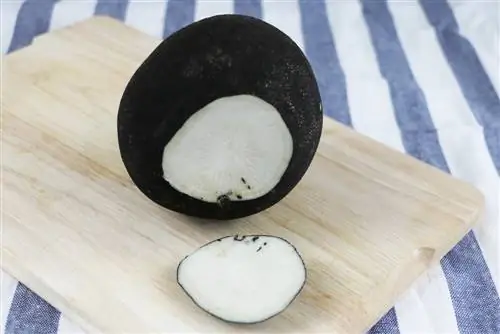
There are several pests that can cause damage to the tuber or greens of radishes. These include flea beetles, which damage the green of young plants. Nets made of fine non-woven fabric can protect against flea beetles. These plants can also be damaged by wireworms. The wireworms directly damage the tubers by producing small feeding burrows. There are also various types of bacteria that can damage the plant.
Harvesting and storage
It usually takes less than ten weeks between sowing and harvesting. As a rule, the radish can be harvested after eight to ten weeks. You only have to be a little more patient with the very late varieties. These radish varieties require approximately 12-15 weeks before they can be harvested. However, the tubers should never be harvested until they are fully grown. This is the only way they stay crunchy and don't lose any of their aroma. If radishes are harvested too late, they may become hard and woody. Sowing should therefore depend on the time of harvest. The radish varieties that ripen in early fall or fall can be stored in a cool and dry place. This is best done in boxes filled with sand. This means the radishes can be stored over the winter. However, the radishes should not be stored on top of each other as they rot so easily. Rotten radishes should be sorted out immediately, otherwise the entire supply can spoil.
Site and soil preparation
Both tuber vegetables require a slightly moist and sunny location. Furthermore, soil that is not too loose and not too dry is recommended for growing radishes. To plant radishes, the soil should be deeply loosened and nutrient-rich.
Sowing
From the beginning of March, the first seeds are sown in cold frames or under foil outdoors. From mid-April to June you can scatter several seeds outdoors. The row spacing should be around 25-30cm and the seeding depth should be around 2-3cm. After germination, the radish should definitely be separated. The distance for early varieties is around 15-20cm, late varieties and especially the Japanese cultivated radishes, which are sometimes huge, should be separated at a distance of 30-40cm. During cultivation, the radish bed needs to be watered regularly. Radishes can be sown from February in cold frames or outdoors under foil. Sowing outdoors is possible from mid-March to the end of September. To do this, the seeds should be sown sparingly in rows, about 20cm apart and covered with a centimeter-thick layer of soil. After germination, the plants are separated to approximately 5-10cm. Sowing and cultivation must always be kept well moist.
Mixed culture & care
Radishes and radishes, as vegetables with medium nutritional requirements, get along quite well with all types of beans. Tomatoes can also be planted on the neighboring bed without any concerns. On the other hand, cucumbers and cruciferous vegetables should not be placed in the neighborhood. A generous supply of water to the plant bed is probably the most important prerequisite for successful radish cultivation.
Harvesting and storage
It takes about 8-10 weeks for radishes from sowing to harvesting. Late varieties usually require a little longer, so you have to expect 13-15 weeks. The tubers should be harvested before they are fully grown so that they remain crunchy and aromatic. Radishes that are harvested too late tend to become woody and hard. The radish that ripens in early autumn can be stored in sand-filled boxes in a cool and dry place. The tubers should be checked regularly during the winter and any rotten specimens should be sorted out. Otherwise there is a risk that the entire supply will spoil.
Pests and diseases
Flea beetles cause damage to the green of young plants, especially during long warm periods in summer. Fine nets made of non-woven fabric protect the plants from the metallic dark blue shimmering beetles. Wireworms can be recognized by their feeding burrows in the root nodules, and they can also infect the plant with bacteria. To do this, you lay out half potatoes or carrots as bait traps, which must be checked regularly.
variety selection
- Radish; Half-long white summer=about 20cm long, white, mild, spicy radish
- Hild's blue autumn and winter=tasty, elongated radish with a long storage time
- Radish; Champion=scarlet red, round radish, spicy taste
- Icicles=long, cylindrical, white variety, very spicy
Profile
- Species/Family: Annual. Belongs to the cruciferous family (Brassicaceae).
- Care effort: Low
- Harvest time: Depending on the variety, harvest until the end of October before heavy frosts set in. Varieties available in white, black, pink, red or blue. Can be stored in a wooden box covered with moist sand in a frost-free place. After several sunny days in a row, like all leafy and root vegetables, only harvest in the afternoon when the nitrate content is lowest
- Foliage: Fern-like, egg-shaped leaves in dark green
- Growth: Fast growing
- Ingredients: iron, calcium, minerals, phosphorus, plenty of vitamin C
- Height: 20 to 25cm
- Location: Sunny to partial shade. Nutrient-rich, deep, permeable, rather moist garden soil. Do not use fresh manure
- Planting time: Can be sown as seeds directly outdoors from March to the beginning of August with a row spacing of 30cm. Pre-cultivation is possible indoors from February, then planted outdoors from April to August. Sowing depth up to 4cm, row spacing approx. 20-30cm. Do not plant or renew soil after radishes, radishes or brassicas on the same planting
- Partners: French beans, peas, strawberries, nasturtiums, cabbage, kohlrabi, lettuce, chard, carrots, parsley, lettuce, spinach, runner beans, tomatoes
- Doesn't get along: cucumbers
- Care: Fertilize with the best seasoned compost. Water abundantly and evenly, the soil must not dry out
- Overwintering: Annual. Sensitive to frost, so harvest before the first frost
- Diseases/problems/pests: Does not tolerate drought and waterlogging, but prefers slightly moist soil at all times, radish flies: place a culture net over the plants (available from specialist retailers)
- Special features: autumn and winter vegetables
Varieties (selection)
- `Hilds Blauer: Blue beets with a hearty taste
- `Mantang Hong F1: Height 25cm. Round turnips the size of tennis balls, white on the outside and red on the inside. Outer white flesh is spicy, inner red flesh is mildly nutty. Harvest from September to November before the first frosts. Perfect for salad. Prefers a sunny location
- `Munich beer: height 20cm. Large white beets that are rounded at the top and sharply pointed at the bottom
- `Rex: Half-long tetraploid variety with typically shaped white beets. Harvest from July to September. Mildly spicy taste
- `Round Black: Quite small, round beets in black

